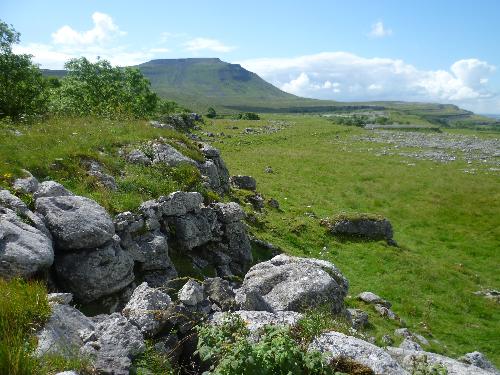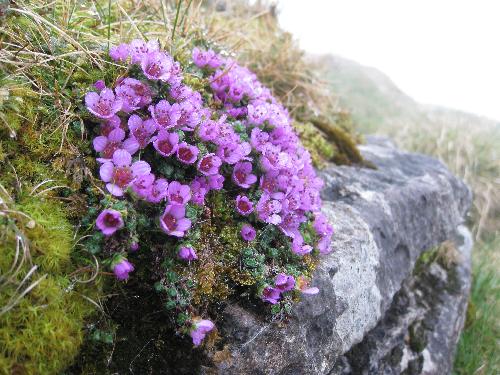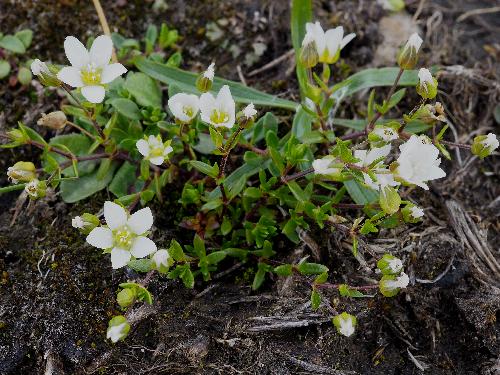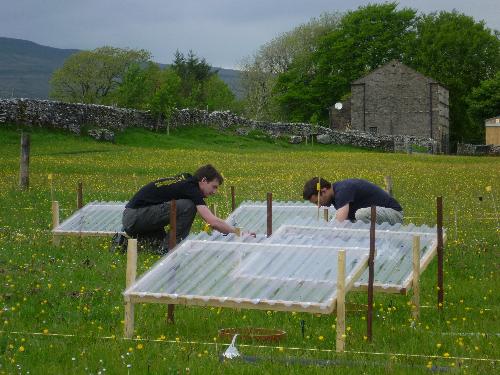| JOURNAL 2021 |
| North Craven Heritage Trust |
Every year thousands of walkers climb up to the summit of Ingleborough, many as part of the arduous Three Peaks route after first climbing Pen-y-ghent and Whernside. To reach the summit from Horton in Ribblesdale or Chapel-le-Dale they will have taken well worn paths through one of this country’s finest National Nature Reserves. They may not be aware of this as they pass through the expansive limestone pastures of Sulber Common or lift tired legs up the steep escarpment on High Lot, their focus being on the goal of the summit and glorious views across to Morecambe Bay. Ingleborough National Nature Reserve (NNR) covers approximately one fifth of the mountain massif, from the roadside pastures and almost to the summit itself. It is a large reserve, set in an outstanding landscape, yet comparatively unknown to those who seek a personal challenge on its slopes each year and even to the communities that live in the surrounding towns and villages.
On the 5th October 1962 a short article in the Craven Herald announced that the Nature Conservancy had purchased Colt Park Wood near Ribblehead and declared it as a National Nature Reserve. The wood had long been known to naturalists for its wildlife value, a fragment of ancient woodland in a largely treeless landscape. Its establishment as a reserve was part of a post-war movement in Britain to protect our most important wildlife and geological sites. The earliest nature reserves were set up at the end of the 19th Century, including purchase of land at Wicken Fen, Cambridgeshire in 1899 by the newly-formed National Trust. The growth of ecology as a natural science in the 20th Century created a wider public and academic interest in the study of wildlife and their habitats and led to the establishment of organisations such as the British Ecological Society (1911) and British Trust for Ornithology (1933). By the outbreak of World War Two there were still very few nature reserves in the country and no framework for their selection or designation, but much work had been done making the case for an integrated and robust system of nature conservation in Britain. This resulted in the passing of the1949 National Parks & Access to the Countryside Act, enabling the creation of our first National Parks, Sites of Special Scientific Interest and NNRs. It also established the Nature Conservancy as the country’s first government wildlife service. The very first NNR declared under the new Act was Beinn Eighe in Scotland in 1950, followed in 1952 by reserves in England, including Moor House in Cumbria.
On Ingleborough the purchase of Colt Park Wood was followed in 1977 by the lease and declaration of Scar Close NNR in Chapel-le-Dale. During the 1980s and early 1990s further land was leased and purchased by the organisation. The Yorkshire Wildlife Trust (YWT) by then had two nature reserves on Ingleborough, at Southerscales and South House Pavement. When English Nature became the government’s new conservation agency in England in 1990, they and the YWT agreed that their owned and leased land should be brought together and declared collectively as Ingleborough NNR. On the 7th June 1993, Prince Charles officially opened the NNR with a ceremony at Philpin Sleights in Chapel-le-Dale. Ingleborough NNR grew in size when English Nature purchased land near Horton-in-Ribblesdale, and again in 2000 with the transfer of Ribblehead Quarry from Hanson UK. The NNR covers 1,012ha and represents the rich biodiversity and geodiversity for which Ingleborough and the Three Peaks area is renowned. It is one of 226 NNRs in England covering over 93,500ha, with many more in Scotland, Wales and Northern Ireland.
Those involved in drawing up the 1949 Act recognised the need for a series of NNRs that would not only encompass the range and diversity of Britain’s natural heritage, but have a specific role in conducting research and experimentation into land management. NNRs thus have three purposes, as set out in the legislation, to conserve their biodiversity and geodiversity, to support and carry out scientific study and to provide opportunities for people to experience and enjoy the natural environment. This last purpose was added in 2006 when Natural England was created under the Natural Environment and Rural Communities Act.
The distinctive landscape of the Three Peaks area, with its valleys edged by scars, screes and stepped terraces of Carboniferous limestone is testament to the power of glaciers that scoured, plucked and ground the bedrock as they moved forward and left a mantle of glacial till as they retreated 17,000 years ago. On this raw, post-glacial surface the process of colonisation by plants and animals began. Evidence of this ancient landscape survives in cave deposits and the oldest peats. They show that wolf, lynx, auroch and wild boar roamed among willow, birch and juniper scrub and, later, woodland of oak, lime, elm and hazel. Over more than 5,000 years people have transformed the land, but in the mosaic of pasture, meadow and moor that covers Ingleborough today there are semi-natural habitats that support a great diversity of wildlife. The whole of the Ingleborough massif, including the NNR, is designated as a Site of Special Scientific Interest (SSSI) for both its biodiversity and geodiversity that includes extensive underground cave systems. The NNR is also part of the Ingleborough Complex Special Area of Conservation (SAC) under the Habitats and Species Directive. Within Ingleborough NNR all the habitats that are characteristic of this upland area are represented, including some of the best examples of their kind. There isn’t space in this article to describe them all in detail or list the many hundreds of species they support. I’ve selected a few that I hope give some idea of what can be seen.
The highest limestone outcrops, on High Lot at over 600m, are home to the beautiful spring flowering arctic-alpine plant, purple saxifrage. Well known to botanists on the perilous crags of Pen-y-ghent it can be seen, quite safely, not far from the Three Peaks route on Ingleborough. As far south as it grows in England, this species was first described for science by one of our early botanical pioneers, John Ray, when he visited Ingleborough in the late 17th Century. These High Lot plants have an uncertain future (as do the other local populations in the Three Peaks), because they are already at the edge of their ecological comfort zone. With any significant warming of the climate there is nowhere for them to move to on Ingleborough and purple saxifrage may no longer be a plant that future generations of botanists are able to see flowering on the high crags in April. Much of the surrounding high ground on the NNR is clothed in blanket bog, rich in sphagnum moss and with acid-loving plants such as hare’s-tail cotton-grass, cloudberry, bilberry, cowberry and heather.
On the benches below its steep slopes, at an altitude of around 300m, Ingleborough’s most distinctive landscape feature and wildlife habitat can be found – limestone pavements. The intricate pattern of blocks (clints) separated by vertical fissures (grikes) are home to a wide variety of ferns and woodland plants such as bluebell, dog’s-mercury, ramsons and the nationally scarce baneberry and rigid buckler fern. Most limestone pavements in the Yorkshire Dales are open and devoid of trees (except for the occasional wind-blasted hawthorn) with vegetation confined to the grikes. It is the grazing effect of animals, particularly nimble-footed sheep, that keep the large expanses of limestone pavement in this open state. Where grazing is excluded, or sheep are replaced by cattle that don’t venture across the treacherous pavement surface, scrub, trees and grike vegetation can grow freely. Colt Park Wood is actually a limestone pavement with mature trees and a rich ground flora that has spread across the clint tops. Allowing limestone pavements to develop a tree and scrub cover with abundant nectar-rich wildflowers draws in birds and insects that are absent from the open pavements. The diversity of resident and migrant birds, including willow warblers and redstarts plus a host of butterflies, moths, bees and hoverflies are a noticeable addition to vegetated pavements.
Limestone pavements on Ingleborough NNR are surrounded by pastures rich in wildflowers adapted to the low nutrient, shallow lime-rich soil. Wild thyme, salad burnet, spring sedge, bird’s-foot trefoil, limestone bedstraw, small scabious, mouse-ear hawkweed and many fine grasses are found in abundance. Like the pavements that they encompass, these pastures are protected by national and international conservation legislation. Grazing is managed to promote flowering of the limestone plants that in turn produce nectar and food for the invertebrate community that lives amongst them. An example is common rock-rose, which is the food plant for caterpillars of the northern brown argus butterfly. The large yellow flowers of the rockrose are not just a delight in themselves, but their waxy green leaves are where the female lays her eggs. If you get close enough you can find these tiny white eggs laid singly on the upper surface. Healthy and abundant rockrose is essential for the northern brown argus, a butterfly that has declined by over 50% since the 1970s. High Brae, a limestone pasture in the southern part of the NNR, has a wonderful display of rockrose and is a good place to look for northern brown argus butterflies on a sunny day in June. The NNR limestone pastures are home to a suite of rare and scarce plants including field gentian, frog orchid and the nationally rare Teesdale violet. Ongoing surveys show that these species are more numerous and widespread on the NNR than previously recorded.
An important moment for the NNR was the establishment of its own herd of hardy cattle in 2003. This was part of the Limestone Country Project, a five year programme to establish new native/hardy breed cattle herds in the Ingleborough and Malham areas. 280ha of the NNR, including High Brae and Sulber Common, are now under a cattle-only regime. This is not only to maintain and enhance the mosaic of grassland and heath communities, but also enable the development of shrub and tree cover on the limestone pavements in these compartments. In a research project by Newcastle University, several of the cattle had GPS collars fitted to study their grazing patterns. The results showed the animals had their preferred grazing areas, but most importantly kept off the pavements. One outcome of this cattle-only grazing has been the proliferation of dark red helleborine, a nationally-scarce orchid that is thriving in the pavements on High Brae.
Of all the plants that attract the eye in the limestone pastures, bird’s-eye primrose is perhaps the prettiest. Anyone who walks the Three Peaks route along Sulber Nick in mid to late May is bound to notice the profusion of small clusters of pink flowers held on short stems above a rosette of greyish-green leaves. It is a nationally scarce species confined to northern England with a strong foothold in the Yorkshire Dales. A plant of alkaline flushes, of which there are many on Sulber, it seems that the cattle have helped spread the plant across much of the common. Growing nearby is one plant species that Ingleborough NNR has almost to itself, English sandwort. This nationally rare annual is endemic to the Carboniferous limestone of the Three Peaks and also known as Yorkshire sandwort. It’s not the most showy of plants, with five white petals held above tiny, fleshy leaves on the thinnest of limestone soils, often close to flushes. Close scrutiny is required because it can be confused with spring sandwort or knotted pearlwort which both grow in the same habitat. It was first found in 1889 at Ribblehead Station and thought to have come in on limestone ballast during construction of the Settle-Carlisle railway. As all the limestone was quarried locally, botanists realised it was native to Ingleborough and searched for other populations. It was found at Selside in 1890 and then in 1898 on Sulber Common by Reginald Farrer, the famous gardener and plant collector. It is a good feeling on a fine day to walk across Sulber to see English sandwort growing in the same places that Reginald Farrer discovered it over 120 years ago.
Although much of the NNR is grazed by livestock, there are areas where grazing has been excluded deliberately. These include the limestone pavements at Scar Close and South House Pavement, but the largest area is South House Moor. Purchased in 1987 this 180ha allotment had been overgrazed with sheep for many years to the detriment of the dwarf shrub plant communities. Initially, grazing was changed to reduce sheep numbers and exclude stock in winter. Although this did have a positive effect, in 2000 the decision was taken to set up a re-wilding experiment by removing all livestock and observe how the vegetation developed in the absence of managed grazing. Studies of peat deposits showed evidence of former woodland so trees such as alder, willow, downy birch and rowan were planted along gills and in other suitable areas. The land had been free of tree cover for so long that natural regeneration was not expected. Twenty years on and the dwarf shrubs are thriving, growing through a thick layer of mosses, including large mounds of colourful sphagnum that develop without being trampled. A study by Lancaster University showed how this vegetation change has benefitted small mammals that are present in much higher numbers on South House Moor compared to the adjacent grazed NNR land. There are an increasing number of re-wilding projects around Britain, such as Wild Ennerdale in Cumbria, Carrifran in southern Scotland, and at Knepp Castle Estate, West Sussex. Ingleborough NNR’s large size has enabled re-wilding to be part of the reserve’s fabric and it will be fascinating to see how South House Moor looks in another twenty years.
Despite all the attention the NNR has received by naturalists over many decades, new discoveries are still being made. For example, in 2015 I received an enquiry from a member of the Craven Conservation Group, looking for a new location to hold a fungal foray. Knowing that there weren’t many fungi records for the NNR I was keen to host the event and mentioned that I’d noticed some colourful fungi in the pastures on Park Fell. The first foray was held there in October and much to everyone’s surprise and delight it revealed a host of waxcaps, corals, clubs, pink gills and earth tongues. Further fungal foray events have taken place since, plus a survey in 2017 by Natural England’s field unit specialists. The result is that Ingleborough NNR is now ranked as one of the top sites in England for grassland fungi, including the very rare date-coloured waxcap known from only one other site in the Yorkshire Dales. Knowledge and understanding do not stand still and there is so much more scope for discovery on the NNR, especially for invertebrates which are relatively under-recorded. However, it is not just about finding new names to add to an ever-growing list. It is what each discovery tells us about the history, management, diversity, climate and health of the reserve and the landscape in which it lies.
One discovery we didn’t wish to make was in 2017, when ash dieback disease was found on the NNR. It is widespread in the Yorkshire Dales now and was inevitable that it would reach the reserve. There is a chapter about Colt Park Wood in Lisa Samson’s 2018 book Epitaph for the Ash. In her visits whilst writing the book ash dieback had not been recorded on the NNR and she wrote about the wood hoping that it would not be affected in the same way as many ash woodlands in Britain. Given that ash is the main canopy tree in Colt Park Wood only time will tell how the disease will reshape this ancient stand, but I hope there is resilience and resistance in those old trees so that the unique character of the wood has ash at its heart.
From the very beginning, research and monitoring of the natural environment has been an important part of the work on Ingleborough NNR. In partnership with many universities and research organisations the NNR has been the focus for scientific studies on hay meadow restoration, ecosystem services, the effects of livestock grazing on grassland biodiversity and carbon storage, climate change impacts and many more. The NNR is an outdoor laboratory where we can experiment, study and learn about the natural world. The longest running research has been at Colt Park, where a series of hay meadows have been studied for over 30 years. Walking through these meadows in the summer, on the public footpath from Colt Park to Selside, visitors are treated to a wonderful display of flowers and might imagine that this is how they have always looked. However, when the land was purchased in 1987 the level ground had been subjected to regular fertiliser applications and the sward was species poor, any remaining meadow plants confined to the banks and rocky margins. In partnership with Newcastle University a project to restore the meadows began. A large enclosure divided into plots was set up, each plot subjected to a combination of different grazing, cutting, seeding and fertiliser/manure treatments. The study showed the importance of traditional, low intensity management in the restoration process. This comprised spring and autumn grazing, cutting after mid-July and no artificial fertilisers. It also showed the benefits of seed addition, especially yellow rattle, a hemi-parasite on grass that reduces its vigour and speeds the process of restoration.The species that returned to the plots such as pignut, red clover, eyebright and rough hawkbit have spread to the surrounding meadow land through the process of haymaking. What started as a restoration study changed in 2010 to a new phase with a focus on the ecosystem services that grasslands provide, especially the plant/soil interaction. Led by Lancaster University the work at Colt Park was part of a wider UK study of grasslands and how their physical characteristics and management affected factors such as carbon sequestration, nutrient cycling, use by pollinators and ability to cope with climate change. A key message that came from this study is that plant diversity and a healthy soil, rich in fungi and micro-organisms, give a grassland the natural resilience it needs to cope with an uncertain future in a warming climate. It is sad to think that the post-war drive for agricultural intensification and increased production, underpinned by government subsidies, has eradicated the majority of such species-rich grasslands across the UK.
Whilst most research on the NNR has been on its physical attributes, in 2019 the Ingleborough Soundscape Project began to study the acoustics of the reserve. In partnership with the Wildland Research Institute at Leeds University, the UK Acoustic Network and Mammal Web, the aim is to assess the ecological and acoustic richness of Colt Park Wood and South House Moor and the impact that the wider environment has on their well-being. A soundscape is the voice of a living habitat. Imagine a woodland dawn chorus but add in all the other animal and natural sounds created throughout the day and night including those that are beyond the frequencies we can hear. Using sophisticated audio recording equipment and computer software it is possible to create a spectogram, a visual representation of the soundscape and the acoustic energy it contains. These can be analysed, compared over time and exist as a permanent record of a habitat in a similar way to a visual survey. The technique was pioneered by an American scientist, Bernie Krause, who started recording wild habitats in the USA and around the world in the 1960s. It is now used to monitor environmental change, especially where human activity (including the noise we generate) is increasing. The project at Ingleborough is capturing the soundscape of two contrasting habitats, both with little human intervention, but subject to noise intrusion from their surroundings. Using acoustic loggers and trail cameras the project has already revealed far more mammal activity than previously known, and the extent to which noise from trains and aircraft mask parts of the natural soundscape.
Since 2009 the NNR has been part of Natural England’s Long Term Monitoring Network. Data is collected on weather, air quality, vegetation, soil and animal populations in a standardised way to allow comparison with other sites in the network. It is used by other nationwide environmental research programmes that record, analyse and predict environmental change in the UK. The NNR is involved in national biodiversity recording initiatives such as the National Amphibian and Reptile Recording Scheme and the National Plant Monitoring Scheme, the latter collecting vegetation data to see how plant abundance and diversity is changing in Britain. There are annual transects to survey birds, bumblebees and butterflies, and light trapping for nocturnal moths. Volunteers make a major contribution to the monitoring programme on the NNR and without their skill and enthusiasm we would know far less about this wonderful nature reserve.
Within the boundaries of the NNR there lies a wealth of historic features which are a record of over 5,000 years of human history. There are ancient settlements and field systems, burial cairns, Medieval walls and earthworks, old lime kilns, washfolds and much more. Since 2012 excavations by the Ingleborough Archaeology Group have revealed new evidence about the Anglo-Saxon period, notably their excavation of a structure in Upper Pasture which, from dating of charcoal samples, was the first 7th Century building to be positively identified in the Yorkshire Dales National Park and one of the earliest known in the north of England. As a means of enjoying the rich archaeological history within the NNR, three archaeology walks supported by a free smartphone app were established in 2016 in partnership with the Ingleborough Archaeology Group and with financial support from the Yorkshire Dales Millennium Trust’s Stories in Stone programme.
Almost all the NNR is Open Access land, but the majority of people passing through the NNR are on one of the public rights of way to the summit or the Pennine Bridleway. Erosion is a recurring problem, especially on the soft peats and thin, species-rich limestone turf. In 2019 a major restoration programme commenced on the NNR in partnership with the Yorkshire Dales National Park Authority. The routes on the NNR through High Brae, Sulber Common and High Lot are the focus for this work over the next two years. These major improvements will make the high traffic routes better to walk on and encourage people to keep to the path and not stray onto adjacent sensitive vegetation – a good result for people and wildlife.
2020 has been a year when human impact on the natural environment has made headline news. From the origins of the Coronavirus pandemic to the climate crisis and the prospect of a global mass extinction of species, it is clear that our stewardship of the natural world is at a critical point. Protecting biodiversity, understanding the complexities of ecosystems, enjoying and promoting the wonders and benefits that a healthy environment provides and working together to achieve these goals has never been more important. The sustainable land management, scientific research and educational work that Natural England and all its partners carry out on Ingleborough NNR is as relevant now as it ever has been since Colt Park Wood was purchased almost sixty years ago.

Ingleborough from Scar Close

Date waxcap

Purple saxifrage on High Lot

English sandwort

Climate change experiment at Colt Park Meadows